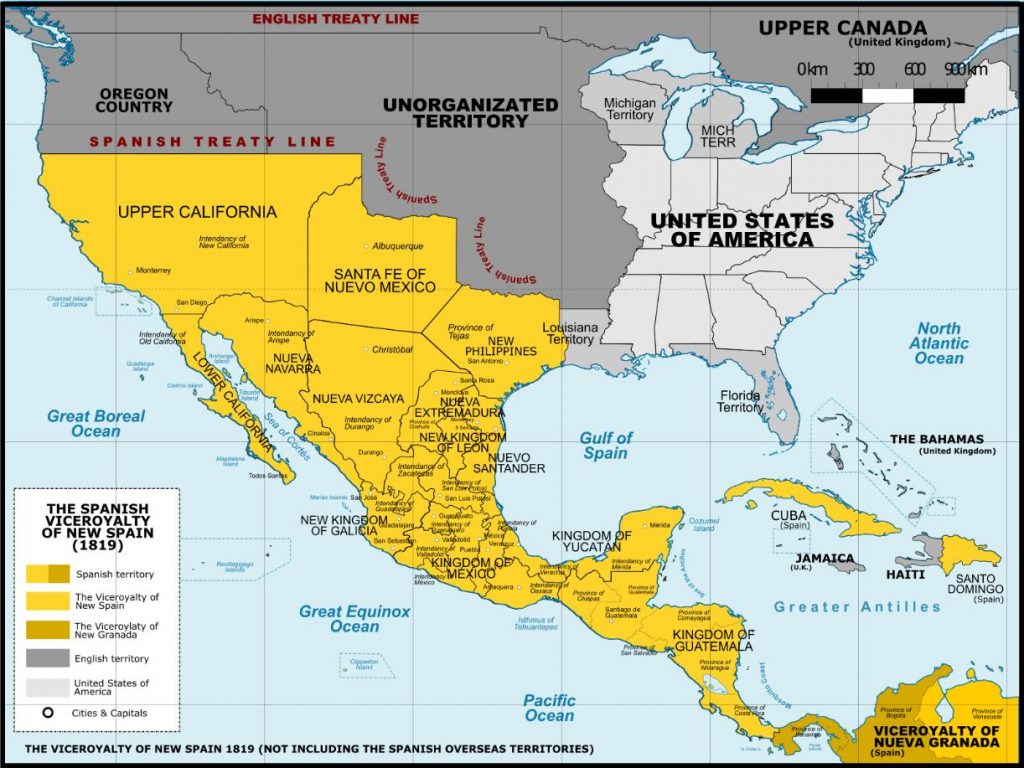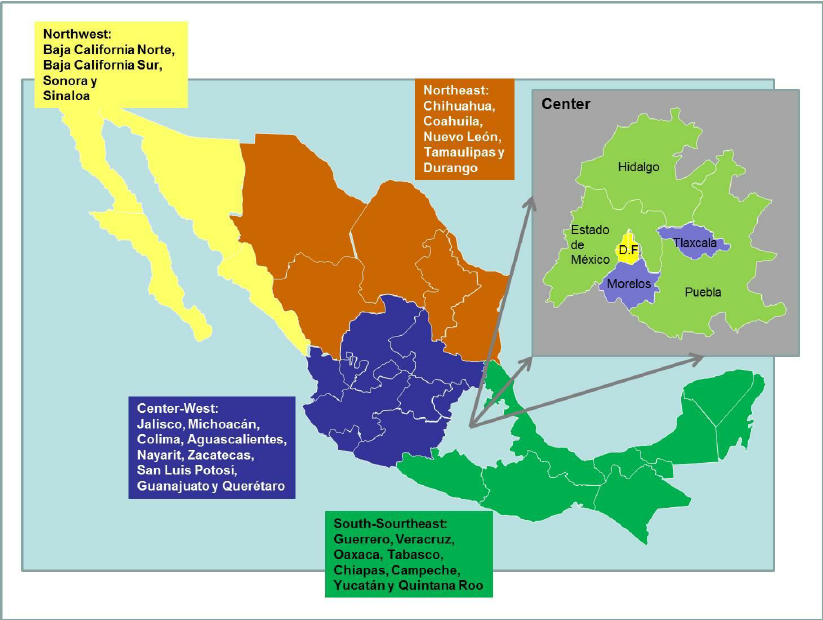Learn the 31 States of Mexico
Many people in English-speaking countries are not familiar with the Spanish names of the states in Mexico. People often refer to cities or tourist destinations as just “Mexico.” The news and politicians talk about “Mexico” often without giving more detail as to the exact location.
Some History – “New Spain”
The lands of the Americas were originally inhabited by over 500 indigenous civilizations. When the Europeans invaded and colonized the Americas, the land now known as “Mexico,” along with other Latin American countries and the Philippines were called “New Spain.”

Mexico’s Independence / USA Territorial Expansion
Mexico won its independence from Spain in 1821 and formed the United Mexican States (Estados Unidos Mexicanos). The new country originally extended from Guatemala to the south, and included the northern territories of Upper California, New Mexico (Arizona and Utah), and Texas.
The United States invaded Mexico and expanded its territory during the Texas Revolution (1835) and the invasion of Mexico, known as the Mexican-American War (1846-1848). Mexico lost almost half of its land.
Mexico Today
Today, the United Mexican States (Estados Unidos Mexicanos) is comprised of 31 states and its capital of Mexico City, which is an autonomous entity on par with the states (a total of 32 voting entities). Mexico is part of the North American continent along with the United States, Canada, and Greenland.

Spanish is the official language of the country, along with 68 different indigenous languages. (A total of 69 official languages.) Many of the state names are derived from these original native languages, or refer to the heroes of the country’s independence.
Mexico is usually described by general Regions: Northwest, Northeast, Center, Center-West, and South-Southwest. School children learn the states in this manner.
Northwest
Baja California: From Latin meaning “hot oven.”
Baja California Sur: From Latin meaning “hot oven.”
Sonora: There are two possibilities: the Yaki Xunuta language, meaning “place de corn” or Sonota, “place of plants.”
Sinaloa: The most accepted theory is that it comes from the Cahita language, “sina” and “lobola”, “pitahaya redonda,” which is a local fruit.
Northeast
Chihuahua: From the Náhuatl language, “Xicahua”, means a dry and sandy place.
Coahuila: According to historians, the name comes from the Náhuatl language and means the “snake that flies.”
Nuevo León: Founded as the New Kingdom of León in reference to the Kingdom of León (lion) of the Iberian Peninsula.
Tamaulipas: From the Huasteca language, the words “Tam” and “Holipo, mean “place of the summits.”
Durango: A Spanish name meaning “beyond water.”
Central Mexico
Ciudad de Mexico – CDMX formerly called the Distrito Federal (Federal District): Similar to Washington, D.C., this is the capital district of the country. While not a state, it is a voting entity.
Hidalgo: In honor of the father of the country Miguel Hidalgo y Costilla.
State of México: It is a Náhuatl word meaning, “in the navel of the moon.”
Morelos: In honor of a hero of the Independence, José Maria Morelos y Pavón.
Tlaxcala: It comes from the Náhuatl word “tlaccalli” meaning the “place of cornbread” or “place of tortillas.”
Puebla: Means “population” and comes from a report by Frey Toribio de Benavente entitled, “Essay of the Puebla de Los Ángeles” in 1531.
Center-West
Jalisco: From the Náhuatl word “Xal “meaning “sand” and” ȉxco”, “in front of the sand” or “surface of the sand,” or Xalixco.
Michoacán: From Náhuatl, “Mich” meaning “fish” and “hua” meaning “can.” It means “where they have fish.”
Colima: From the Náhuatl word “Coliman”, a place conquered by our grandparents.
Aguas Calientes: Refers to the hot springs found in that region.
Nayarit: Nayar, Naye, or Nayarit is the name of the king of the Cora people, who confronted the Spanish.
Zacatecas: From the word “zacatl” that means the “place of pasture.”
San Luis Potosí: In honor of San Luis IX and the Cerro de San Pedro mine, compared to the mining city of Potosí, in Bolivia.
Guanajuato: From the native language of Purépecha, the word “Kuanasi” means “frog” and “Kuanasïuatu” means “hill”. It is the “place on the hill of the frogs.
Querétaro: From the Purépecha word “Crettaro” means “place of hardship.”
South/Southwest
Guerrero: In honor of the country’s independence and president of the Republic, Vicente Guerrero.
Veracruz: Founded on Good Friday by the Spaniards as Villa Rica de la Vera Cruz (true cross).
Oaxaca: From the Náhuatl word “huaxyacac” means “the top of the jaguars”, although it is also translated as “in the nose of the jaguars.”
Tabasco: Among several hypotheses, two are from the Náhuatl words “tlapalco” meaning “humid earth” or “tlahuasco”, the “place that is owned.”
Chiapas: From the Chiapan language referring to the river of Chia.
Campeche: From Maya and Peech, meaning the land of snakes and ticks.
Yucatán: From Yucatan Maya, the words “Yuk ak Katán” mean “I do not understand you” or possibly from uuy u t’an which means “hear how they speak.”
Quintana Roo: In honor of Andrés Quintana Roo, a hero of the Independence.
Now, we all know more about Mexico!
Related Articles:
